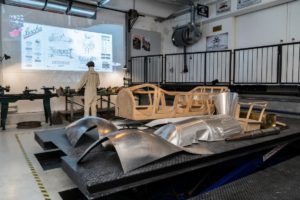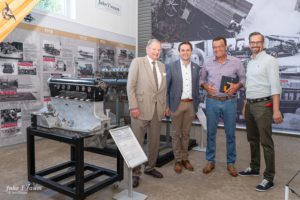Special exhibition: The history of Austro Daimler from 1899 to 1935
New exhibition hall and exhibits that have never before been shown in the fahr(T)raum Ferdinand Porsche Worlds of Experience!
During the coronavirus-induced break, the fahr(T)raum team has been busy planning a large special exhibition on the history of the Austro Daimler automotive brand during the time of Ferdinand Porsche. The exhibition presents the diversity of the company’s products in a clear and detailed manner and is divided into four thematic areas: Austro Daimler – the brand, commercial vehicles, rail and aviation. A demonstration workshop and interactive elements take visitors back to that period in time. In order to maintain an overview, an Austro Daimler engine chronology was developed at the time of Ferdinand Porsche, which shows the milestones of the automotive brand in the historical context.
Jakob Iglhauser, Managing Director of the fahr(T)raum Ferdinand Porsche Worlds of Experience, is pleased to be able to present exhibits that have never before been shown, such as an ADGR all-terrain vehicle, an ET13 post bus, a draisine and the pioneering 6 and 12-cylinder aircraft engines, a Hansa Brandenburg C1 engine with 6 cylinders and 225 PS as well as the ADR engine with 6 cylinders and 70 PS, narrow-gauge railway engines with 3.5 and 6 PS and the M12 marine engine. A separate building has even been built directly adjacent to the vintage and classic car museum in order to have enough space for the new exhibits.
Austro Daimler produced not only luxury motor vehicles and commercial vehicles, but also hunting wagons, trucks, buses, rail vehicles and aircraft engines. The first vehicle produced by “Österreichische Daimler-Motoren-Commanditgesellschaft, Bierenz, Fischer & Co.”, founded in Wiener Neustadt in 1899, was a “4-horsepower” two-cylinder engine with an electromagnetic ignition (built in 1900).
Ferdinand Porsche started his career as Technical Director at “Österreichische Daimler Motoren Gesellschaft” on 19 July 1906 and managed the company successfully together with Eduard Fischer and Wilhelm Strauß until he left in 1923. Highlights of his career at Austro Daimler included the development of the Maja 24/28 HP, the first purely petrol-driven car, the type 22/86 “Prinz Heinrich” sports car from 1910 and the Sascha ADS-R racing car (built in 1922).
You can see in the exhibition what happened after Ferdinand Porsche’s departure, how the company restructured itself in times of war and what ingenious inventions it produced.
Special exhibition Austro Daimler:
30. July 2020 – 29. September 2021
daily from 10:00 am to 5:00 pm
Quellen
This might also interest you:









NEW at fahr(T)raum: Steyr Type 30 Cabriolet (1931)
/w Bez kategorii, Geschichte, Sonstige FahrzeugeFerdinand Porsche, who has gone down in history as a pioneer of automotive engineering, developed a car for the upper middle class for the Steyr-Werke in 1929: following his career as Technical Director at Austro Daimler (1906-1923). He very advantageously reengineered, as instructed by Steyr, the Steyr type XX and created a substantially new model […]
Now on exhibit at fahr(T)raum: the world´s only Austro Daimler ADV Boat Tail!
/w Bez kategorii, Geschichte, Sonstige FahrzeugeThe last design which Ferdinand Porsche engineered as technical director for Austro Daimler is now on display at fahr(T)raum Mattsee: the Austro Daimler ADV Boat Tail. It was built in Wiener Neustadt in 1923, but it received its unique chassis – the „Boat Tail” – in the 1950s in the USA. The ADV is a […]
New exhibit at fahr(T)raum – 1916 Austro Daimler 2-cylinder Feldbahn engine
/w Bez kategorii, Geschichte, MotorenField and industrial railways (Feldbahnen) have assisted the transport of agricultural, forestry and industrial raw materials and products since the 19th century. They offered high transport performance with simultaneous low energy consumption (low rolling resistance of the wheel-rail system). Their use is mainly associated with the processing industry, such as, e.g., chamotte or sugar factories […]